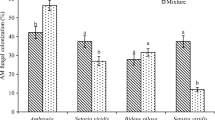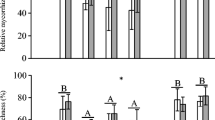Abstract
Ambrosia artemisiifolia L. (common ragweed), an annual invasive plant, was introduced more than 100 years ago from North America to Europe. Like the majority of other invasive plants in Europe, it develops in open, disturbed areas such as fields, wastelands, roadsides, and riverbanks. Recently, arbuscular mycorrhizal fungi (AMF) have been suspected to play a role in some plant invasion processes. As the common ragweed is known to be colonized by AMF in its native range, the intensity of mycorrhizal root colonization was studied in 35 natural populations in eastern France. About 94% of the A. artemisiifolia populations sampled were mycorrhizal. Root colonization levels varied from 1 to 40% depending on the ecological sites, with lower levels for agricultural habitats and higher levels in disturbed sites, such as wastelands or roadsides. A subsequent greenhouse experiment showed positive impacts of AMF on the growth and development of A. artemisiifolia. It is proposed that the spread of this invasive plant species could be facilitated by AMF, underlining the need to integrate symbiotic interactions in future work on invasive plant processes.




Similar content being viewed by others
References
Barni E, Siniscalco C (2000) Vegetation dynamics and arbuscular mycorrhiza in old-field successions of the western Italian Alps. Mycorrhiza 10:63–72
Bassett IJ, Crompton CW (1975) The biology of Canadian weeds: 11-Ambrosia artemisiifolia L. and A. psilostachya DC. Can J Plant Sci 55:463–476
Berch SM (1979) Endomycorrhizae of southern Ontario ferns. MSc thesis, University of Waterloo, Waterloo
Bruno JF, Fridley JD, Bromberg KD, Bertness MD (2005) Insights into biotic interactions from studies of species invasions. In: Sax DF, Stachowicz JJ, Gaines SD (eds) Species invasions: insights into ecology, evolution and biogeography. Sinauer, Sunderland, MA, pp 13–40
Caussanel J-P, Chollet C, Gianinazzi S (2000) Arbuscular mycorrhizas of Ambrosia artemisiifolia L. and perspectives for biological control. 13th AFEDA symposium, Lyon, pp 34–35
Chauvel B, Dessaint F, Cardinal-Legrand C, Bretagnolle F (2006) The historical spread of Ambrosia artemisiifolia L. in France from herbarium records. J Biogeogr 33:665–673
Chollet D, Drieu Y, Molines J, Pauget J (1999) Comment lutter contre l’ambroisie à feuilles d’armoise. Perspect Agric 250:78–82
Clot B, Schneiter D, Tercier P, Gehrig R, Annie G, Thibaudon M (2002) Ambrosia pollen in Switzerland: local production or transport? Allergie Immunol 34:126–128
Coleman JS, McConnaughay KDM, Ackerly DD (1994) Interpreting phenotypic variation in plants. Trends Ecol Evol 9:187–191
Crowell HF, Boerner REJ (1988) Influences of mycorrhizae and phosphorus on belowground competition between two old-field annuals. Environ Exp Bot 28:381–392
Déchamp C, Caussanel J-P (2002) Exigences écologiques et milieux colonisés. In: Déchamp C, Méon H (eds) Ambroisies, polluants biologiques. Arppam, Lyon, pp 47–58
Déchamp C, Méon H (eds) (2002) Ambroisies, polluants biologiques. Arppam, Lyon
Deen W, Swanton CJ, Hunt LA (2001) A mechanistic growth and development model of common ragweed. Weed Sci 49:723–731
Fumanal B, Plenchette C, Boissel A, Roulin A, Chauvel B, Bretagnolle F (2004) Premiers résultats sur la biologie d’Ambrosia artemisiifolia L.: symbioses mycorhiziennes. 16ème Colloque Pluridisciplinaire AFEDA, Lyon, pp 9–10
Fumanal B, Chauvel B, Bretagnolle F (2005) Life-history traits of an allergenic European invasive plant: Ambrosia artemisiifolia L. International symposium on introduction and spread of invasive species, Berlin, pp 225–226
Furlan V, Fortin JA (1975) A flotation-bubbling system for collecting endogonaceae spores from sieved soil. Nat Can 102:663–667
Furlan V, Fortin JA, Plenchette C (1983) Effects of different vesicular–arbuscular mycorrhizal fungi on growth of Fraxinus americana. Can J For Res 13:589–593
Genton B, Kotanen P, Cheptou P-O, Adolphe C, Shykoff J (2005a) Enemy release but no evolutionary loss of defence in a plant invasion: an inter-continental reciprocal transplant experiment. Oecologia 146:404–414
Genton BJ, Shykoff JA, Giraud T (2005b) High genetic diversity in French invasive populations of common ragweed, Ambrosia artemisiifolia, as a result of multiple sources of introduction. Mol Ecol 14:4275–4285
Giovannetti M, Mosse B (1980) An evaluation of techniques for measuring vesicular–arbuscular mycorrhizal infection in roots. New Phytol 84:489–500
Guillerm JL, Le Floc’h E, Maillet J, Boulet C (1990) The invading weeds within the western Mediterranean basin. In: Di Castri AJ, Debussche M (eds) Biological invasions in Europe and the Mediterranean basin. Kluwer, Dordrecht, pp 61–84
Grime JP, Hunt R (1975) Relative growth-rate: its range and adaptive significance in a local flora. J Ecol 63:393–422
Heckel E (1906) Sur l’Ambrosia artemisiifolia L. et sa naturalisation en France. Bull Soc Bot Fr 53:600–620
Jin L, Gu YJ, Xiao M, Chen JK, Li B (2004) The history of Solidago Canadensis invasion and the development of its mycorrhizal associations in newly-reclaimed land. Funct Plant Biol 31:979–986
Keane RM, Crawley MJ (2002) Exotic plant invasions and the enemy release hypothesis. Trends Ecol Evol 17:164–170
Klironomos JN (2002) Feedback with soil biota contributes to plant rarity and invasiveness in communities. Nature 417:67–70
Koide RT, Li MG (1991) Mycorrhizal fungi and the nutrient ecology of three oldfield annual plant species. Oecologia 85:403–412
Koide RT, Shumway DL, Mabon SA (1994) Mycorrhizal fungi and reproduction of field populations of Abutilon theophrasti Medic. (Malvaceae). New Phytol 126:123–130
Kovacs GM, Bagi I (2001) Mycorrhizal status of plants in a mixed deciduous forest from the great Hungarian plain with special emphasis on the potential mycorrhizal partners of Terfezia terfezioides (MATT.) TRAPPE (Pezizales). Phyton-Ann Rei Bot A 41:161–168
Kovacs GM, Szigetvari C (2002) Mycorrhizae and other root-associated fungal structures of the plants of a sandy grassland on the great Hungarian plain. Phyton-Ann Rei Bot A 42:211–223
Laaidi M, Laaidi K, Besancenot JP, Thibaudon M (2003) Ragweed in France: an invasive plant and its allergenic pollen. Ann Allergy Asthma & Immun 91:195–201
Marler MJ, Zabinski CA, Callaway RM (1999) Mycorrhizae indirectly enhance competitive effects of an invasive forb on a native bunchgrass. Ecology 80:1180–1186
Maron JL, Vila M (2001) When do herbivores affect plant invasion? Evidence for the natural enemies and biotic resistance hypotheses. Oikos 95:361–373
Medve (1984) The mycorrhizae of pioneer species in disturbed ecosystems in western Pennsylvania. Am J Bot 71(6):787–794
Muller S (2000) Les espèces végétales invasives en France: bilan des connaissances et propositions d’actions. Rev Ecol 7:53–69
Nuortila C, Kytoviita M-M, Tuomi J (2004) Mycorrhizal symbiosis has contrasting effects on fitness components in Campanula rotundifolia. New Phytol 164:543–553
Phillips JM, Hayman DS (1970) Improved procedures for clearing roots and staining parasitic and vesicular–arbuscular mycorrhizal fungi for rapid assessment of infection. Trans Br Mycol Soc 55:158–161
Philip LJ, Posluszny U, Klironomos JN (2001) The influence of mycorrhizal colonization on the vegetative growth and sexual reproductive potential of Lythrum salicaria L. Can J Bot 79:381–388
Pimentel D (ed) (2002) Biological invasions: economic and environmental costs of alien plant, animal, and microbe species. CRC, New York
Plenchette C (1989) Mycorrhizal soil infectivity of Deherain’s plots. C R Acad Agric Fr 75:23–29
Plenchette C, Duponnois R (2005) Growth response of the saltbush Atriplex nummularia L. to inoculation with the arbuscular mycorrhizal fungus Glomus intraradices. J Arid Environ 61:535–540
Plenchette C, Declerck S, Diop T, Strullu DG (1996) Infectivity of monoaxenic subcultures of the AM fungus Glomus versiforme associated with Ri-TDNA tranformed root. Appl Microbiol Biotechnol 46:545–548
Prinzing A, Durka W, Klotz S, Brandl R (2002) Which species become aliens? Evol Ecol Res 4:385–405
Read DJ, Birch CPD (1988) The effects and implications of disturbance of mycorrhizal mycelial system. Proc R Soc Edinb 94B:13–24
Read DJ, Koucheki HK, Hodgson J (1976) Vesicular–arbuscular mycorrhiza in natural vegetation systems. I. The occurrence of infection. New Phytol 77:641–653
Richardson DM, Allsopp N, D’Antonio CM, Milton SJ, Rejmanek M (2000) Plant invasions—the role of mutualisms. Biol Rev 75:65–93
Roy J (1990) In search of the characteristics of plant invaders. In: Di Castri AJ, Debussche M (eds) Biological invasions in Europe and the Mediterranean basin. Kluwer, Dordrecht, pp 335–352
Rudgers J, Mattingly W, Koslow J (2005) Mutualistic fungus promotes plant invasion into diverse communities. Oecologia 144:463–471
Sakai AK, Allendorf FW, Holt JS, Lodge DM, Molofsky J, With KA, Baughman S (2001) The population biology of invasive species. Ann Rev Ecolog Syst 32:305–332
Schreiner RP, Koide RT (1993) Mustards, mustard oils and mycorrhizas. New Phytol 123:107–113
Stanley MR, Koide RT, Shumway DL (1993) Mycorrhizal symbiosis increases growth, reproduction and recruitment of Abutilon theophrasti medic in the field. Oecologia 94:30–35
Stampe ED, Daehler CC (2003) Mycorrhizal species identity affects plant community structure and invasion: a microcosm study. Oikos 100:362–372
Török K, Botta-Dukat Z, Dancza I, Németh I, Kiss J, Mihaly B, Magyar D (2003) Invasion gateways and corridors in the Carpathian bassin: biological invasions in Hungary. Biological Invasions 5:349–356
Vitousek PM, D’Antonio CM, Loope LL, Rejmanek M, Westbrooks R (1997) Introduced species: a significant component of human-caused global change. N Z J Ecol 21:1–16
Waterer D, Coltman R (1989) Response of lettuce to pre- and post-transplant phosphorus and pre-transplant inoculation with a VA-mycorrhizal fungus. Plant Soil 117:151–156
Williamson MH (ed) (1996) Biological invasion. Chapman & Hall, London
Williamson MH, Fitter A (1996) The characters of successful invaders. Biol Conserv 78:163–170
Acknowledgements
This work was partly supported by the Regional Council of Rhône-Alpes and the Regional Council of Burgundy. Roulin A., Petit C., Sabatier N., and Gaujour E. are acknowledged for their assistance. We also thank Dalpé Y. for AMF spore identification, and Demizieux J.-L. for his helpful comments on the manuscript.
Author information
Authors and Affiliations
Corresponding author
Rights and permissions
About this article
Cite this article
Fumanal, B., Plenchette, C., Chauvel, B. et al. Which role can arbuscular mycorrhizal fungi play in the facilitation of Ambrosia artemisiifolia L. invasion in France?. Mycorrhiza 17, 25–35 (2006). https://doi.org/10.1007/s00572-006-0078-1
Received:
Accepted:
Published:
Issue Date:
DOI: https://doi.org/10.1007/s00572-006-0078-1




